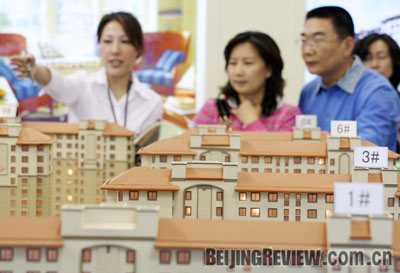| 
WAIT AND SEE: The Chinese property market, propped up by excessive liquidity,
is expected to cool down in the second half of this year
The report issued by People's Bank of China on August 15 indicated rosy results for the country's monetary policy during the second quarter of this year. The good news was that the central bank said the nation's financial market was "moving smoothly toward the macroeconomic control direction" it had set. It also said China's financial market had weathered the storms of the U.S. subprime mortgage crisis, serious domestic natural disasters, the appreciation of the renminbi and inflation.
Going up
Since the second half of 2006, China's financial market has been suffering from serious liquidity problems, because too much money is in circulation. As a result, the consumer price index (CPI), a barometer for inflation, soared 8.7 percent in June year on year, the second highest level in history since the figure has been calculated.
Yet, money supply growth has been decreasing. The central bank report indicated that by the end of June, the outstanding balance of broad money, or M2, had amounted to 44.3 trillion yuan ($6.49 trillion), an increase of 17.4 percent year on year, and was 0.7 percentage point lower than the growth rate at the end of May. The outstanding balance of narrow money, or M1, stood at 15.5 trillion yuan ($2.27 trillion), an increase of 14.2 percent year on year, while the growth rate was 6.7 percentage points lower than that at the end of June last year. Cash in circulation, or M0, stood at 3 trillion yuan ($439 billion) by the end of June, an increase of 12.3 percent year on year, while the growth rate was 2.3 percentage points lower than the same period last year.
"The money supply growth rate is decreasing, showing the excessive liquidity problem is now being relieving as is inflation pressure," said He Liping, a finance professor at Beijing Normal University.
The central bank report gave two reasons for the money supply slowdown. First, the bank had stepped up its efforts to absorb excessive money. In the first half of this year, it withdrew 19.4 billion yuan ($2.84 billion) by raising the reserve requirement ratio and interest rates.
The second reason was that big fluctuations in the capital market had forced a huge amount of money to flow back into the banking system so that individual and corporate fixed deposits soared year on year. The central bank report showed that by the end of June, the residents' renminbi deposits had risen 1.5 trillion yuan ($220 billion) year on year, and corporate fixed deposits had grown 758 billion yuan ($111 billion).
The supple yuan
The Chinese currency has been appreciating since the government introduced a policy of exchange rate reform in July 2005. At the end of June, the central parity of the renminbi against the U.S. dollar was 6.8591. The renminbi has appreciated 20.66 percent against the U.S. dollar, depreciated 7.54 percent against the euro, and appreciated 13.33 percent against the Japanese yen since 2005.
|
